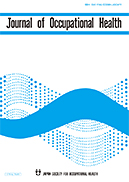61 巻, 6 号
選択された号の論文の12件中1~12を表示しています
- |<
- <
- 1
- >
- >|
Issue Information
-
原稿種別: ISSUE INFORMATION
2019 年 61 巻 6 号 p. 427-428
発行日: 2019/11/20
公開日: 2019/11/25
PDF形式でダウンロード (754K)
Editorial
-
原稿種別: EDITORIAL
2019 年 61 巻 6 号 p. 429-430
発行日: 2019/11/20
公開日: 2019/11/25
PDF形式でダウンロード (81K)
Originals
-
原稿種別: ORIGINAL ARTICLE
2019 年 61 巻 6 号 p. 431-441
発行日: 2019/11/20
公開日: 2019/11/25
PDF形式でダウンロード (651K) -
原稿種別: ORIGINAL ARTICLE
2019 年 61 巻 6 号 p. 442-452
発行日: 2019/11/20
公開日: 2019/11/25
PDF形式でダウンロード (352K) -
原稿種別: ORIGINAL ARTICLE
2019 年 61 巻 6 号 p. 453-463
発行日: 2019/11/20
公開日: 2019/11/25
PDF形式でダウンロード (231K) -
原稿種別: ORIGINAL ARTICLE
2019 年 61 巻 6 号 p. 464-470
発行日: 2019/11/20
公開日: 2019/11/25
PDF形式でダウンロード (209K) -
原稿種別: ORIGINAL ARTICLE
2019 年 61 巻 6 号 p. 471-480
発行日: 2019/11/20
公開日: 2019/11/25
PDF形式でダウンロード (413K) -
原稿種別: ORIGINAL ARTICLE
2019 年 61 巻 6 号 p. 481-488
発行日: 2019/11/20
公開日: 2019/11/25
PDF形式でダウンロード (851K) -
原稿種別: ORIGINAL ARTICLE
2019 年 61 巻 6 号 p. 489-497
発行日: 2019/11/20
公開日: 2019/11/25
PDF形式でダウンロード (283K) -
原稿種別: ORIGINAL ARTICLE
2019 年 61 巻 6 号 p. 498-507
発行日: 2019/11/20
公開日: 2019/11/25
PDF形式でダウンロード (359K) -
原稿種別: ORIGINAL ARTICLE
2019 年 61 巻 6 号 p. 508-516
発行日: 2019/11/20
公開日: 2019/11/25
PDF形式でダウンロード (506K)
Recognition of Reviewers
-
原稿種別: RECOGNITION OF REVIEWERS
2019 年 61 巻 6 号 p. 517-518
発行日: 2019/11/20
公開日: 2019/11/25
PDF形式でダウンロード (64K)
- |<
- <
- 1
- >
- >|
